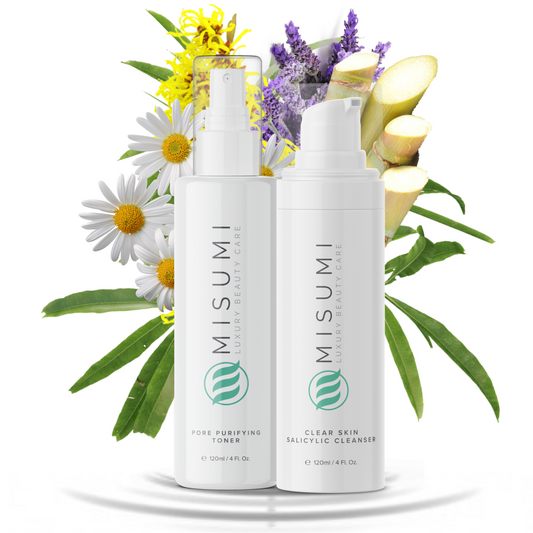Have you ever wondered, "what causes excess oil on face and scalp"? Oily skin and scalp can be a real challenge, as they often lead to acne breakouts, clogged pores, and greasy hair. In this comprehensive guide, we'll delve into the root causes of excess oil, so you can better understand and manage this common skin and hair issue.
The Science Behind Excess Oil Production

The sebaceous glands in our skin are responsible for producing sebum, a mixture of fatty acids, sugars, waxes, and other chemicals that protect and hydrate the skin and hair. Sebum is the body's natural moisturizer and is essential for maintaining healthy skin and scalp. However, when these glands produce too much sebum, it can lead to oily skin, clogged pores, and acne.
There are several factors that can cause excess oil production, including:
1. Fluctuating Hormones
Hormonal changes, such as those that occur during puberty, menstruation, pregnancy, or menopause, can increase sebum production. In some cases, oral contraceptives or hormone replacement therapy may also contribute to oily skin and scalp.
2. Scalp Issues and Health Conditions
Certain scalp conditions like seborrheic dermatitis can cause excess oil production. This condition is characterized by scaly patches, redness, and white flakes on the scalp.
3. Diet
Foods high in sugar, saturated fat, or dairy products have been linked to excess oil production and acne.
4. Medications
Some medications, such as corticosteroids or birth control pills, can alter hormone levels and increase sebum production.
5. Overwashing and Harsh Products
Washing your face and hair too frequently or using harsh chemicals can strip the skin of its natural oils, causing the sebaceous glands to produce more oil to compensate.
How to Manage Oily Skin and Scalp

To manage oily skin and scalp, consider incorporating these tips into your skincare and hair care routine:
- Regular Skincare and Hair Care: Cleanse your skin and hair regularly, but avoid overwashing. Choose gentle, oil-free products that won't strip your skin of its natural oils.
- Stay Hydrated: Drinking plenty of water can help maintain the balance of your skin's natural oils and reduce sebum production.
- Dietary Changes: Limit foods high in sugar, saturated fat, and dairy products. Instead, opt for a well-rounded diet full of whole foods, fruits, and vegetables.
- Home Remedies: Aloe vera gel has anti-inflammatory and antibacterial properties that can help soothe irritated skin and reduce sebum production. Apply a thin layer of aloe vera to your face or scalp for a natural remedy.
- Consult a Dermatologist: If your oily skin or scalp persists despite your efforts, consult a dermatologist. They can help determine the underlying cause and recommend appropriate treatments, such as salicylic acid or prescription medications.
Prevention Tips for Excess Oil on Face and Scalp

To prevent excess oil production and maintain a healthy scalp, try the following tips:
- Avoid Harsh Chemicals: Choose gentle, oil-free products for your skincare and hair care routine. Harsh products can strip the skin of its natural oils and trigger more sebum production.
- Moisturize Appropriately: Even oily skin needs moisturization. Opt for lightweight, oil-free moisturizers that won't clog pores.
- Use Sunscreen: Sun exposure can lead to excess oil production. Always wear a broad-spectrum sunscreen with at least SPF 30, and choose an oil-free formula designed for oily skin.
- Shampoo Properly: When washing your hair, focus on massaging the shampoo into your scalp to remove oil buildup. Use a gentle, sulfate-free shampoo specifically designed for oily hair.
- Avoid Over-Brushing: Over-brushing your hair can stimulate the sebaceous glands and distribute oil throughout your hair, making it appear greasier. Stick to brushing your hair just enough to detangle and style it.
- Limit Heat Styling: Using hot tools, like flat irons and curling wands, can stimulate sebum production. Limit heat styling, and when necessary, use the lowest heat setting possible.
- Rinse with Cool Water: Rinsing your hair with cool water can help close hair follicles and reduce sebum production. This also helps keep your hair looking shiny and healthy.
- Use Dry Shampoo in Moderation: While dry shampoo can be a lifesaver for greasy hair, using it too frequently can clog hair follicles and lead to excess oil production. Limit your use of dry shampoo and make sure to wash your hair with a gentle shampoo regularly.
- Manage Stress: High levels of stress can stimulate the adrenal glands to produce more sebum. Incorporate stress-reducing activities, like exercise, meditation, or deep breathing, into your daily routine.
- Maintain a Healthy Lifestyle: A healthy lifestyle that includes regular exercise, a balanced diet, and sufficient sleep can help regulate hormone levels and maintain a healthy scalp.
Understanding what causes excess oil on face and scalp is crucial for managing oily skin and hair. By making simple changes to your skincare and hair care routines, as well as maintaining a healthy lifestyle, you can effectively control excess oil production and enjoy healthier, more balanced skin and hair. Remember, if your oily skin or scalp persists despite your efforts, consult a dermatologist for personalized advice and treatment options.

Maintaining Clear, Healthy Skin with the Misumi Complete Clear 3-Step System
Navigating the skincare world in search of the perfect regimen to keep your facial skin clean and clear can be overwhelming. The need for a simple yet effective skincare routine is particularly crucial for individuals grappling with acne and breakouts. Misumi's Complete Clear 3-Step System presents an all-in-one solution uniquely designed for such needs.
Misumi, known for its high-quality, results-oriented skincare products, has formulated the Complete Clear 3-Step System for optimal skin clarity. Comprising the AHA 10% Skin Perfecting Cleanser, Pore Purifying Toner, and Wrinkle-Free All Day Moisturizer with SPF 30, this system is meticulously curated to combat acne while promoting clean and clear skin.
Step 1: AHA 10% Skin Perfecting Cleanser
Starting your skincare routine with a powerful yet gentle cleanser sets the foundation for clear skin. The AHA 10% Skin Perfecting Cleanser by Misumi provides a deep cleanse that removes dirt, oil, and makeup residues that could lead to acne.
Furthermore, with 10% Alpha Hydroxy Acids (AHA), this cleanser gently exfoliates the skin, preventing the buildup of dead skin cells that often lead to clogged pores. Regular use leaves your skin clean, clear, and primed for the next steps in your regimen.
Step 2: Pore Purifying Toner
Following up cleansing with a potent toner is critical in maintaining clear skin. Misumi's Pore Purifying Toner helps tighten pores and balance the skin's pH levels, making it less susceptible to acne-causing bacteria. By eliminating residual impurities and preparing the skin for subsequent hydration, this toner plays an integral role in keeping your skin clean and clear.
Step 3: Wrinkle-Free All Day Moisturizer with SPF 30
Hydration and sun protection are vital in any skincare regimen. Misumi's Wrinkle-Free All Day Moisturizer with SPF 30 provides hydration without contributing to oiliness or clogging pores. With the added benefit of SPF 30, this moisturizer shields your skin from harmful UV rays, which can lead to breakouts and skin damage. This leaves your skin not only hydrated but also protected and less prone to acne.
The Clear Skin Advantage with Misumi's 3-Step System
The Misumi Complete Clear 3-Step System offers a comprehensive approach to managing acne-prone skin. Regular and consistent use allows active ingredients to work effectively, leading to noticeable improvements over time. However, remember that clear skin doesn't stop at topical treatments.
A balanced diet rich in antioxidants, adequate hydration, sufficient sleep, and stress management are equally crucial in maintaining clean and clear skin. As every individual's skin is unique, patience and consistency are key while awaiting visible improvements.
Misumi's Complete Clear 3-Step System provides an easy-to-follow regimen that addresses acne, promotes clean skin, and enhances your skin's overall health. Always consult with a dermatologist or skincare professional if you're dealing with persistent acne or other skin concerns. After all, the journey to clear skin is a personal one and well within your reach.
The Connection Between Excessive Oil Production and Acne: An In-depth Analysis
If you're grappling with acne, understanding the causes and underlying factors can empower you to manage the condition more effectively. One common instigator of acne is the overproduction of oil, or sebum, by your skin's sebaceous glands. This phenomenon can impact both your facial skin and scalp.
Oil Production: A Balancing Act
Sebum, the oil produced by the sebaceous glands, is a vital component of your skin's health. It provides moisture, safeguards the skin against infectious agents, and helps maintain your skin's barrier function. However, when produced in excess, sebum can lead to an oily complexion and a range of associated concerns, including acne.
The Journey from Oil Overproduction to Acne
The journey to acne begins when sebum overproduction meets dead skin cells. Typically, these cells are naturally shed and replaced with new ones. But when your skin produces excess oil, these cells can stick together, leading to clogged pores.
Bacteria, specifically Propionibacterium acnes (P. acnes), reside naturally on our skin and pose no harm. However, when trapped in these clogged pores, they multiply rapidly, feeding on the trapped sebum. This bacterial growth triggers inflammation and the formation of acne lesions.
This process is not limited to your face. An oily scalp can also experience similar problems, leading to scalp acne. Like your face, your scalp also has sebaceous glands that can produce excess oil.
Mitigating Excess Oil Production
Addressing oily skin and scalp requires a multi-faceted approach. For your face, consider a regimen like Misumi's Complete Clear 3-Step System. The AHA 10% Skin Perfecting Cleanser can effectively cleanse your skin, the Pore Purifying Toner can balance your skin's pH, and the Wrinkle-Free All Day Moisturizer with SPF 30 can hydrate without adding extra oil.
For an oily scalp, consider using shampoos designed for oily hair. These products can help to control sebum without stripping the scalp of essential moisture. Avoid heavy conditioners that can weigh down hair and increase oiliness.
A balanced diet rich in fruits, vegetables, and lean proteins can also help manage oil production. Additionally, stress management and adequate sleep can contribute to overall skin health. Remember, while it's essential to keep your skin clean, over-washing can strip the skin of its natural oils, prompting it to produce even more sebum.
When to Seek Professional Help
If despite your best efforts, your skin remains excessively oily and acne persists, consulting with a dermatologist can be beneficial. They can provide professional advice and potentially prescribe treatments that can help manage oil production and combat acne.
In conclusion, while the overproduction of sebum can lead to acne, it's crucial to remember that this condition is common and manageable. With an understanding of your skin and the right care regimen, you can effectively control oil production and pave the way towards clearer, healthier skin.







